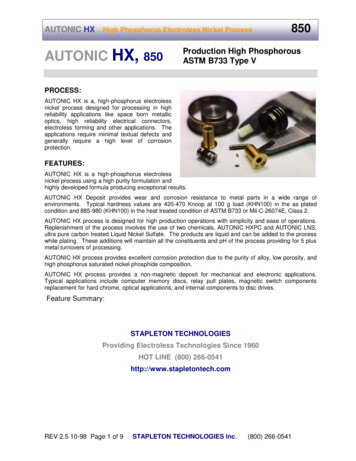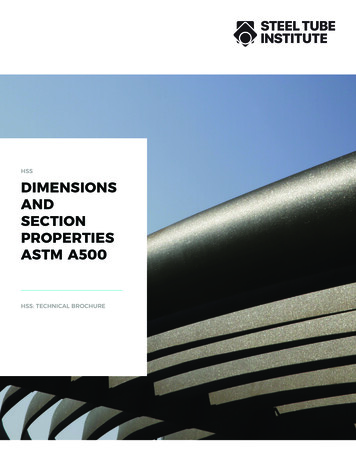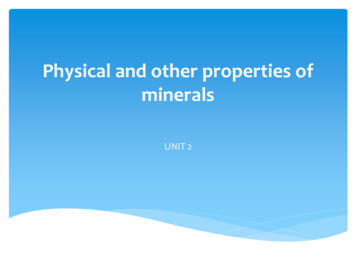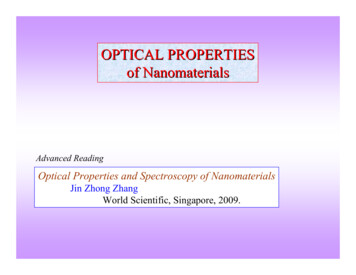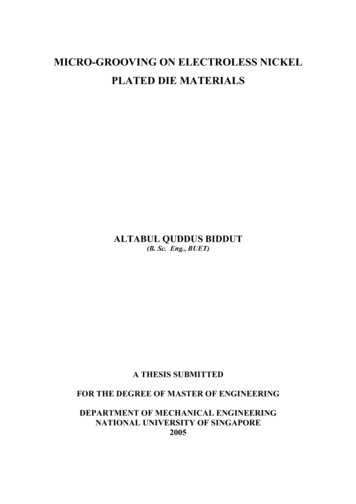
Transcription
Nickel Development InstituteProperties and applicationsofelectroless nickelRon ParkinsonThe information contained in this publication has been compiled from the literature and through communication with recognizedexperts within the metal finishing industry. It is presented as a guide to the use of electroless nickel for engineers, metallurgists,designers and others involved in materials selection.The important properties of electroless nickel deposits are described and examples given of how these properties have beenused successfully to solve materials problems in various industries. Through presentation of this information, it is anticipated thatnew opportunities for the use of electroless nickel coatings will become apparent to those not already familiar with their broad rangeof properties, thereby promoting growth within the industry.1Properties and applications ofelectroless nickel
Nickel Development InstituteIntroductionElectroless nickel plating is a process for depositing a nickelalloy from aqueous solutions onto a substrate without theuse of electric current. It differs, therefore, from electroplating which depends on an external source of directcurrent to reduce nickel ions in the electrolyte to nickel metalon the substrate. Electroless nickel plating is a chemicalprocess which reduces nickel ions in solution to nickel metalby chemical reduction. The most common reducing agentused is sodium hypophosphite. Alternatives are sodiumborohydride and dimethylamine borane but they are usedmuch less frequently. It is estimated that sodiumhypophosphite is used in more then 99% of all electrolessnickel plating1 and this publication refers only to the use ofthis reducing agent.It is not the intention of this publication to provide detailsof the electroless nickel process but rather to review theproperties of the deposits and describe successful applications. Some of the unique properties of electrolessnickel, such as thickness uniformity, hardness, corrosionresistance and magnetic response have resulted in its usein many different industries. In spite of this, not all designers, engineers, metallurgists and others responsible formaterials selection are aware of the value of electrolessnickel as an engineering or functional coating. However, it isfirmly established as a functional coating in the electronics,oil and gas, chemical, aerospace and automotive industries,for instance. It is also recognized and used effectively inmany others and the number of applications continues togrow.In the following pages, the engineering properties ofelectroless nickel are described and applications have beenselected to demonstrate how these properties have beenused to resolve materials problems. The information presented should provide those involved in materials selection,with sufficient background to enable cost effective decisionsto be made. Some of these decisions will favour electrolessnickel, thereby benefitting the industry and ensuringcontinued growth.3Properties and applications ofelectroless nickel
Nickel Development InstituteProperties of Electroless NickelComposition and StructureThere are major differences between electrodeposited nickeland electroless nickel that are associated with their purityand structure. For instance, the purity of electrodepositednickel is typically greater than 99% but when sodiumhypophosphite is used as a reducing agent in electrolessnickel plating, a typical composition for the deposit is 92%nickel and 8% phosphorus. The phosphorus content has agreat effect on deposit properties and it can be varied over awide range, typically 3 to 12%. The industry normallyidentifies electroless nickel coatings according to their phosphorus content, e.g.Low phosphorus2 - 5% P.Medium phosphorus6 - 9% P.High Phosphorus10 - 13% P.Consequently, once the performance requirements for thecoating have been defined, it is essential that the appropriatetype of electroless nickel be specified. For instance, thereare distinct differences in the corrosion resistance andhardness properties of low and high phosphorus deposits, asdescribed later.The structure of electroless nickel is responsible for someof its unique properties. It differs greatly from the crystallinestructure of electrodeposited nickel and it can normally bedescribed as having an amorphous structure or one con2sisting of ultra fine crystallites. The amorphous nature of thedeposits becomes more dominant with increasing phosphorus content and above 10.5%, deposits are consideredtruly amorphous. The absence of a well-defined crystalstructure eliminates the possibility of intergranular corrosionthat can be a problem with crystalline deposits, such aselectrolytic nickel. Electroless nickel, therefore, provides amore effective barrier coating in protecting a substrate fromcorrosive attack.Heat treatment of nickel-phosphorus deposits can causesignificant changes in properties and structure. X-ray diffraction examination shows substantial crystallinity andsegregation of the deposit into small crystallites of two distinct phases, nickel metal and nickel phosphide (Ni3P). Somevolume shrinkage is associated with the recrystallization andthis can result in cracking in high and medium phosphorusdeposits.Figure 1Effect of composition on deposit density.Melting PointElectroless nickel does not have the high temperatureproperties of pure nickel, e.g. high temperature oxidationresistance. Pure nickel has a melting point of 1455 C but thephosphorus content of electroless nickel has a very significant effect on its melting point, as shown in Figure 2. Thefinal melting point curve declines almost linearly from 1455 Cto 880 C for an alloy containing 11% phosphorus. This is thelowest melting point (eutectic) for the nickel/ phosphorussystem and some melting will occur at this temperature,regardless of the phosphorus content, provided it is greater4than 0.2%.Physical PropertiesDensityThe density of pure nickel is 8.9g/cm3. The density ofelectroless nickel is not constant and decreases appreciablywith increasing phosphorus content. For instance, a depositcontaining 3% phosphorus has a density of 8.52 g/ cm3 while3 3at 11 %, the density is only 7.75g/cm . The relationshipbetween phosphorus content and density is shown in Figure41.Figure 2Effect of composition on melting point.Thickness UniformityA feature of great importance in all applications forelectroless nickel is the ability to produce deposits with avery high degree of thickness uniformity. It is obvi-5Properties and applications ofelectroless nickel
Nickel Development Instituteously beneficial when coating complex parts with criticaldimensions, such as ball valves or osited nickel is due to the fact that no currentis involved and the associated problems of currentdistribution do not exist. Uniform thickness ofelectrodeposits is not easy to obtain and becomes moredifficult with increasing complexity of the part. Improvedcurrent distribution can be obtained by a suitable choiceof electrolyte, the use of auxiliary anodes and shieldsand by optimizing rack design. However, it is almostcertain that the thickness uniformity available byelectroless plating will not be achieved on complex partsby electroplating. As electroless nickel plating is achemical process with no current flow involved, the rateof nickel deposition on all areas should be equal,provided uniform solution conditions are maintained.Temperature, pH, agitation and solution composition arethe parameters that control deposition rates and uniformthickness will be obtained unless these are allowed tovary across the surface of the part. The wideacceptance and growth of electroless nickel plating canbe attributed in part to this outstanding feature ofdeposit uniformity, even on complex components.Figure 3 provides an example of the difference inthickness uniformity of nickel deposited electrolyticallyand by the electroless process.Figure 3Figure 4Effect of composition on electrical resistivity.Heat treating of electroless nickel decreases the resistivity. This can occur at temperatures as low as 150 C butthe most significant changes occur at temperatures whichcause a structural change by precipitation of nickel phosphide, i.e. typically 260 to 280 C.Magnetic PropertiesThe magnetic properties of electroless nickel are of extreme importance as they have been responsible for oneof the single largest applications for high phosphorusdeposits, i.e. as an underlayer for magnetic coatings inthe production of memory discs.The magnetic response of electroless nickel varies4greatly with phosphorus content, as shown in Figure 5.The ferromagnetism associated with high purity nickeldecreases dramatically with increasing phosphorus content and deposits with over 11% phosphorus are3described essentially as non-magnetic. This conditioncan be maintained even after heat treatment at 260 C fora short time but once the precipitation of nickel romagnetism will increase.Comparison of deposit uniformity.Electrical Properties-6The resistivity of high purity nickel is 7.8 x 10 ohmcm,but that of electroless nickel can be as much as ten timesgreater. This results from the disruption of the regularlattice structure of high purity nickel by the codeposition ofphosphorus and consequently resistivity of electrolessnickel increases with increasing phosphorous content.-6Typically, values are in the range of 30 to 100 x 10 ohmcm, as shown for low, medium and high phosphorus4deposits in Figure 4.Properties and applications ofelectroless nickelFigure 56Effect of composition on magnetic properties.
Nickel Development InstituteThermal PropertiesThe coefficient of thermal expansion of electrolessnickel coatings varies from 22.3 µm/m/ C at 3%4phosphorus to 11.1 at 11% phosphorus. For comparison,the value for high purity electrodeposited nickel is in therange 14 to 17 pm/m/ C.Mechanical PropertiesHardnessNote: Hardness values in this publication are presented inunits used in the reference literature. No conversions havebeen made.Hardness of electroless nickel is a very important factorin many successful applications. In the ‘as-deposited’ condition it is strongly influenced by the phosphorus content2as shown in Figure 6 - but all deposits have greater hardFigure 7Effect of one hour heat treatment and phosphoruscontent on hardness.It can be seen that ‘as-deposited’ hardness is greaterfor low phosphorus deposits but the hardness of all typesincreases dramatically to a range of approximately 850 to950 HK100.Increased hardness can be obtained at lower temperatures but longer times are required. Phosphorus content isalso a factor in the hardening rate. Prolonged exposure ofhigh phosphorus deposits to heat treatment temperatureshas very little effect on hardness, as the major phasepresent is the inherently hard nickel phosphide. The effect2is shown in Figure 8.Figure 6Effect of composition on the microhardness of asplated deposits.ness values than electrodeposited nickel e.g. typicalKnoop microhardness values range from 500 to 720compared to only 150 - 400 HK100.Furthermore, of very special interest is the effect ofheat treatment. The hardness of electrodeposited nickeldecreases significantly on heat treatment due torecrystallization and grain growth. However, heattreatment of electroless nickel results in a dramaticincrease in hardness to levels similar to those ofchromium plate. It is for this reason that electroless nickelis used increasingly to replace chromium plate inapplications requiring a coating with hard, wear-resistantproperties. The case for electroless nickel is greatlyenhanced by the vastly superior thickness uniformity ofthe deposits and the serious environmental issuesassociated with chromium plating.The optimum temperature range for heat treatment is345 to 400 C. The effect of heat treatment for one hour at6these temperatures is shown in Figure 7 for electrolessnickel deposits containing from 1 to 10% phosphorus.Figure 8Heat treatment behavior of high phosphorus deposits.Low phosphorus deposits behave differently and prolonged exposure to heat treatment temperatures results ina decrease in hardness from the maximum attainable. Anexample of this is shown in Figure 9 for a deposit contain-7Properties and applications ofelectroless nickel
Nickel Development Institute2ing 2% phosphorus. This effect is attributed to the presence of two distinct crystalline phases-nickel metal andnickel phosphide and some associated grain growth.Figure 9by abrasion or erosion, for instance, and because it isa complex process, it is necessary to select theoptimum method of protection based on the specificconditions involved. There is not one best protectivecoating against wear but because of the greatversatility of electroless nickel, it can be used toresolve many different wear problems.Hardness is certainly not the only factor inassessing wear-resistant coatings but it is a veryimportant one in many cases. Electroless nickelcoatings in the as-plated condition have goodresistance to abrasion and erosion, although they arenot as hard as some other coatings such aselectroplated chromium. However, hardness and wearresistance can be increased by heat treatment tovalues similar to those of chromium and this, plus theenvironmental concerns with chromium, has resultedin some substitutional opportunities.In situations involving wear, in which two metallicsurfaces are in contact, galling may occur, particularlyif the hardness of the two surfaces are similar. Theability to change the hardness of electroless nickel byheat treatment or by control of the phosphoruscontent, can be used to advantage to prevent galling,especially if both contact surfaces are electrolessnickel.There are various methods of investigating wear resistance. Abrasive wear resistance is often determinedby applying abrasive media to a test piece andmeasuring the weight or dimensional loss of materialunder standard conditions. The Taber Abrader is mostcommonly used. Wear conditions are produced on thetest piece by a rotating abrasive wheel and the weightloss is determined after each 1000 rotations. Fromthese values, the Taber Wear Index (TWI) iscalculated and typical results for as-deposited andheat-treated electroless nickel deposits with a range of2phosphorus contents are shown in Figure 10.Heat treatment behavior of low phosphorus deposits.It is shown that the hardness of electroless nickel can becontrolled over a wide range. Figure 7 shows this range tobe approximately 450 to 950 HK100, which is dependent onphosphorus content and heat treatment time and temperature. The process has proven to be capable of producingdeposits with consistent composition and hardness, whichcan be heat treated to provide increased hardness whenrequired. Recommended heat treatments for the threetypes of electroless nickel to obtain maximum hardness areshown in Table I.Table I Heat Treatment to Obtain Maximum HardnessPhosphorus Content (%)Heat Treatment2-51 hour at 400 - 425 C6-91 hour at 375 - 400 C10 - 131 hour at 375 - 400 CIt must be emphasized that although heat treatment canbe used to increase hardness, other property requirementsmust be considered. For instance, it can reduce corrosionresistance, especially with high phosphorus deposits.Wear ResistanceElectroless nickel coatings have good wear resistancebecause of their high hardness and good, natural lubricity.Wear resistance can be enhanced by heat treatment and, ifnecessary, by the codeposition of particulate matter suchas silicon carbide, diamond, alumina, fluorinated carbonand polytetrafluoroethylene.Wear can be defined as the loss of material from asurface as a result of mechanical action. It can be causedFigure 10Properties and applications ofelectroless nickel8Effect of composition on Taber wear resistance.
Nickel Development InstituteIt is clear that the low phosphorus deposits provide betterwear properties in the as-deposited condition and this wouldnaturally be attributed to greater hardness. However, the factthat the results obtained with the heat-treated deposits followa similar trend suggests that hardness is not the only factor,as heat treatment produces similar hardness valuesthroughout the range of phosphorus contents shown.Phosphorus content in the heat-treated samples is of greatersignificance than hardness with this test method.The results of Taber Abrader tests have shown that highand low phosphorus deposits in the as-deposited and heattreated conditions are much superior to electrodepositednickel from a Watts solution. In addition, heat treated lowphosphorus deposits gave similar results to electroplated7chromium.DuctilityElectroless nickel deposits have low ductility and phosphorus content within the normal operating range has very7little effect, as shown in Figure 11. They are hard, brittlecoatings and elongation to fracture is typically only 1 to2.5%. Normal heat-treatment procedures for electrolessnickel increase hardness and reduce ductility.Internal stress is rarely, if ever, measured on a depositactually applied to a part. It is conveniently measured on aBrenner-Senderoff spiral contractometer, which provides astress value that indicates the condition of the platingsolution at that time. Electroless nickel deposited at thesame time should have the same stress.Stress is dependent on the substrate being plated,' theformulation and condition of the bath and in some cases,on its age. Organic and metallic impurities in solution canalso significantly effect stress.High phosphorus deposits are compressively stressedwhen plated from a new bath but generally the stressbecomes progressively more tensile as the bath ages. Lowphosphorus deposits are in a state of compressive stressfrom new or aged baths and those with medium4phosphorus contents are in a state of tensile stress. TheFigure 12Effect of composition on internal stress.relationship between composition and internal stress is4shown in Figure 12.Figure 11Corrosion ResistanceEffect of composition on ductility.The corrosion resistance of electroless nickel is one of themajor reasons for its widespread use as a protectivecoating. However, it must be emphasized that all electroless nickel deposits do not perform in the same way andthat the type must be selected to meet the requirements ofthe specific exposure conditions. For instance, high phosphorus deposits are inferior to low phosphorus deposits inelevated temperature, strongly alkaline media but superiorin neutral or acidic media. Other factors that must beconsidered to optimize corrosion protection include thenature and surface condition of the substrate, the thicknessof the deposit and any postplating requirements such asheat treatment.Electroless nickel does not perform as a sacrificial coating in the same way that zinc or cadmium perform on steelsubstrates to provide protection against corrosion. It be-Internal StressInternal stress refers to a force, free from external forcesthat is created within the deposit that tends to change theshape of the deposit in order to relieve the force. When thestress is tensile, it is in a contractile state in which thedeposit tends to contract in order to relieve the stress. Whenthe stress is compressive, it is in an expansive state inwhich the deposit will tend to expand to relieve the stress.Stress can be sufficiently high to influence the properties ofsome substrates. For instance, the fatigue life of some highstrength steels can be reduced when deposits are in a stateof high internal stress but this can occur with other stressedcoatings, not only electroless nickel.9Properties and applications ofelectroless nickel
Nickel Development Institutehaves as a true barrier coating between the corrosive environment and the substrate. Consequently, the thickness ofthe deposit and the absence of porosity are of great importance. Generally, electroless nickel deposits have veryuniform thickness and very low porosity. Porositydecreases with increasing thickness and any tendencytowards the formation of porous coatings is greatly reduced2in deposits containing over 10% phosphorus. Theamorphous nature of these high phosphorus deposits isadvantageous in corrosive environments for two reasons.5Firstly, unlike polycrystalline materials, amorphous alloysdo not have grain boundaries at which corrosion sites canbe initiated. Secondly, they form passive, glassy surfacefilms, which provide added protection.The surface condition of the substrate can have a significant effect on porosity in electroless nickel and generallythicker deposits are recommended for rougher substratesto ensure low porosity and optimum corrosion resistance.Properties and applications ofelectroless nickelFor instance, to obtain minimum porosity in coatings onrelatively smooth substrates, a thickness of 25 microns has5been recommended. For rough or sandblasted substrates,a thickness of 50 to 75 microns has been suggested.These thicknesses are derived from porosity studies onlyand are not necessarily optimum values for maximumcorrosion protection. Required thickness must be based onthe severity of the environmental conditions.Electroless nickel is frequently required to provide corrosion protection and wear resistance. Heat treatment isoften used to increase hardness and improve wear properties. However, at the temperatures used, an increase in theporosity of the coating generally occurs with a corresponding decrease in corrosion resistance. This is probably due2to the formation of microcracks and is of most concernwith high phosphorus deposits. Additional comments oncorrosion resistance are made in the Chemical ProcessIndustry section.10
Nickel Development InstituteApplicationsChemical Process IndustryElectroless nickel is widely used in the chemical processindustry. Innovative and less expensive substratematerials have found applications when used inconjunction with electroless nickel coatings, as alternativesto some high cost, traditional materials that have notalways provided consistent and reliable performance. Toensure continued growth, the industry has actively soughtmethods of reducing the cost of storage, manufacture andtransportation of chemical products. In turn, the searchhas resulted in increased demand for electroless nickeland the implementation of standards, which haveimproved the reliability of the performance of constructionmaterials.Requirements for materials used in the chemical process industry include a need to maintain product purity, toprevent corrosion/erosion problems that may effect theenvironment and to optimize cost and service life of equipment. Electroless nickel has excellent corrosionresistance, is not susceptible to stress corrosion crackingand can be deposited with a range of composition for usein acidic, neutral or alkaline conditions. It has thereforebeen evaluated extensively by the chemical processindustry to determine its performance as a function ofphosphorus content and to establish relative economicinformation and performance capabilities. The result hasbeen acceptance of the coating for use in a broad range ofapplications.It is important to realise that it is insufficient to simplyspecify electroless nickel for coating components as thecomposition of the deposit can have a dramatic effect on8performance. Examples of this have been reported for avariety of chemicals including thionyl chloride,orthochlorobenzyl chloride, phosphorus oxychloride,benzotrichloride and benzoyl chloride. However, the effectof the composition of electroless nickel coatings is clearlyevident from the results of corrosion tests made in twomore commonly used and very important chemicals in thisindustry i.e. phosphoric acid and sodium hydroxide.Figures 13 and 14 show corrosion rates for low, mediumand high phosphorus deposits on mild steel inphosphoric acid and sodium hydroxide respectively. Thephosphorus contents of the deposits were 1-2%, 6-8% and10-11%. The superior performance of high phosphorusdeposits in phosphoric acid and of low phosphorus depositsin sodium hydroxide clearly demonstrates the importance ofcomposition.Figure 13 Effect of Composition of Electroless Nickel onCorrosion Resistance in Phosphoric Acid (75 Wt %)at 40 C.The importance of specifying the type of electroless nickelis further demonstrated in Table II. It compares the performance of low, medium and high phosphorus deposits withalternative materials, in various sodium hydroxide solutions8frequently encountered in the chlor-alkali industry .Low phosphorus deposits are shown to be superior tohigher phosphorus deposits, N02200 (Nickel 200) andS31600 stainless steel (316S.S.) but in making comparisons,there is some need for caution. It must be emphasized thatelectroless nickel is used as a coating deposited on asubstrate material and under inadequately controlled con-Table II Comparison of the corrosion rates of electroless nickel coatings in caustic solutions with other commonly used materials.All corrosion rates in microns/year, 100 days exposure.Caustic SolutionN02200(Nickel 200)EN CoatingsLPMPMild SteelHP45%Na0H 5%NaCI@40 C2.50.30.30.845%Na0H 5%NaCI@140 1600(316 SS)35.66.4No data27.99452.0533.483.81448332.7Properties and applications ofelectroless nickel
Nickel Development InstituteFigure 14 Effect of Composition of Electroless Nickel onCorrosion Resistance in Sodium Hydroxide (45%) at40 C.ditions can be susceptible to the formation of imperfectionssuch as porosity or pitting. Satisfactory performance isdependent on the absence of such imperfections as exposure to the substrate material could lead to rapid failure ofthe parts. The alternative materials shown are uncoatedmetals and alloys, whose performance is dependant mainlyon composition and metallurgical condition, rather thanquality and adhesion of a protective coating.In the chemical process industry, electroless nickel isfrequently in competition with fibreglass reinforced plastics,mild steel, S31600 stainless steel, N02200, glass-lined steeland teflon-lined steel. Cost comparisons, for using thesematerials in the construction of closed vessels and pipingsystems were made in 1986 and are shown in Appendix 18and 2 respectively . A similar comparison for bolting8applications is given in Appendix 3 .There are many applications in the chemical processindustry where electroless nickel has been used successfully. In general terms low phosphorus electroless nickel hasbetter corrosion resistance in strong alkaline environmentsthan does high phosphorus electroless nickel. On the otherhand, high phosphorus deposits have better resistance tochemicals that may hydrolize to produce weak acidenvironments. In addition, electroless nickel can provideprotection to substrates that are susceptible to stress corrosion cracking. The phosphorus content of these deposits istherefore obviously of great importance but many otherproperties are also important in the industry, e.g. hardness,wear resistance and galling resistance. In addition, the importance of the adhesion of the deposit to the substrate andthe continuity of the coating i.e. the absence of pitting orProperties and applications ofelectroless nickelporosity, cannot be over-emphasized. Electroless nickelcoatings provide corrosion resistance by preventing contactbetween the substrate and the environment. They arecathodic or non-sacrificial coatings when applied over steeland therefore continuous pore free deposits aremandatory. Minimum thickness recommendations aretypically 40 microns but in severe corrosive environments75 microns may be preferred. The ferroxyl test described inASTM B733 and the salt fog test in ASTM B117 arevaluable in determining if coatings are free from porosity.However, results are not always reproducible and the latteris destructive to the coating and requires 24 to 48 hours forcompletion. An alternative method has recently been reported9 that is based on measuring the mixed potential ofa metal surface, consisting of the electroless nickel coatingand a ferrous substrate exposed by pores to a corrosiveelectrolyte. The method is reported to be more sensitivethan the ferroxyl test and comparable to the salt fog test.However, it has the advantage of being fast andnon-destructive.10It has been reported that the surface finish of the substrate can significantly influence the protective value ofelectroless nickel deposits. Generally, smoother substratesurfaces provide better quality electroless deposits andmechanical surface treatments and fabrication procedurescan result in surface imperfections. These include grit blasting, casting, rolling, stamping, shearing, lapping, drawing,machining and others. Surface imperfections can result inentrapment of solutions which in turn can cause servicefailure. Improvements to the electroless nickel process arecontinuously being made and reliable preparation techniques are now available for most substrate materials.Applications for electroless nickel have been found inthe processing, storage and transportation of chemicals.The following are examples of successful applications.Electroless nickel has been used extensively in thechloralkali industry, in which the two main products arechlorine and sodium hydroxide obtained by the electrolysisof sodium chloride, i.e. brine. As produced, chlorine has atemperature of 80 C, is wet and contains some hydrogen,air, carbon dioxide and nitrogen. It must be cooled, dried,purified and compressed to about 0.4MPa (60psi) for liq10uefaction. Steel compressors at a chlor-alkali plant in theU.S. Gulf coast area provided less than one year of serviceand failure was attributed to build up of sodium sulphateand ferric chloride resulting in corrosion and erosionproblems. Although ferric chloride is aggressive toelec
Nickel Development Institute ing 2% phosphorus.2 This effect is attributed to the pres- ence of two distinct crystalline phases-nickel metal and nickel. Properties and applications of
